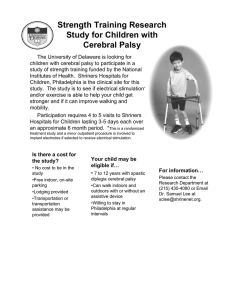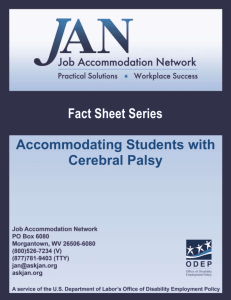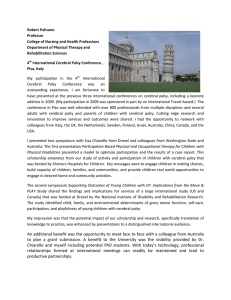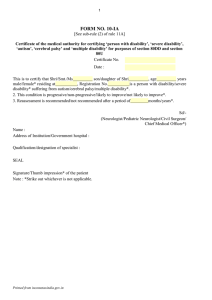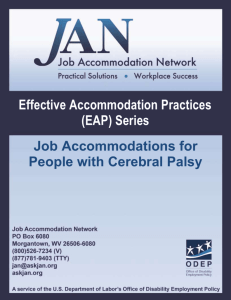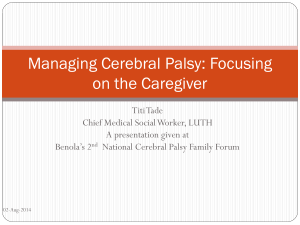14 Cerebral Palsy, Traumatic Brain Injury, and Stroke
advertisement
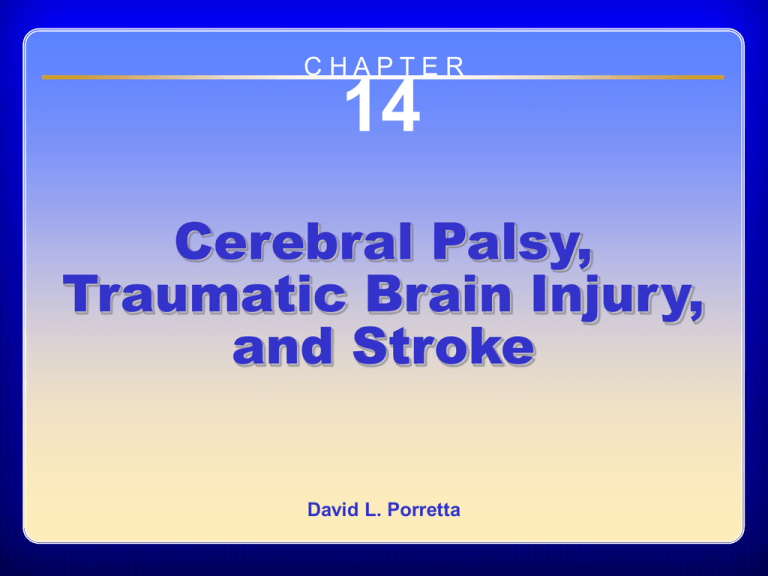
CHAPTER 14 Cerebral Palsy, Traumatic Brain Injury, and Stroke David L. Porretta Chapter 14 Cerebral Palsy, Traumatic Brain Injury, and Stroke Cerebral Palsy • A group of permanently disabling conditions • Damage to motor control areas of the brain • Symptoms vary from mild (only slight speech impairment) to severe (total inability to control body) • Other symptoms associated with cerebral palsy (e.g., speech and language, mental retardation, sensory impairments) • Premature infant five times more likely to be born with CP than full-term baby Three Classification Schemes of Cerebral Palsy • Topographical (anatomical) • Neuromotor (medical) • Functional (movement related) Topographical Classification of Cerebral Palsy • Monoplegia—any one body part • Diplegia—major involvement of both lower limbs or minor involvement of both upper limbs • Hemiplegia—one complete side of the body (arm and leg) • Paraplegia—both lower limbs only • Triplegia—any three limbs involved (rare) • Quadriplegia—total body involvement (all four limbs, neck, and trunk) Neuromotor Classification of Cerebral Palsy • Spasticity—increased muscle tone • Athetosis—low uncoordinated movements, involuntary movements • Ataxia—abnormal hyptonicity, balance problems, clumsiness, awkwardness Functional Classification of Cerebral Palsy • Class I—poor range of motion, strength, and trunk control; motorized wheelchair • Class II—poor strength and trunk control; propels wheelchair on level surfaces with legs only • Class III—fair to normal strength in one extremity; propels wheelchair independently; may walk short distances with assistance • Class IV—good strength and minimal control problems in arms and torso; uses assistive devices for distance; chair used for sport (continued) Adapted by permission from National Disability Sport Alliance, 2008. Functional Classification of Cerebral Palsy (continued) • Class V—good strength and balance; moderate involvement in legs; no chair, may use assistive devices • Class VI—fluctuating muscle tone; ambulates without aids; function varies; better mechanics running than walking • Class VII—good functional ability on unaffected side; walks or runs without aids; shows asymmetrical action • Class VIII—good balance; minimal coordination problems; runs and jumps freely; little to no limp; maybe slight loss of coordination in one leg Adapted by permission from National Disability Sport Alliance, 2008. Cerebral Palsy: Educational Considerations • Managed, not treated • Alleviating symptoms caused by brain damage • Managing motor function—improving muscle control, muscle relaxation, functional skills • Abnormal reflex development—interferes with development of functional skills (e.g., kicking and throwing balls) • Physical therapy • Primary concern—to develop total person (use of collaboration or team approach) Traumatic Brain Injury • Insult to the brain affecting physical, cognitive, social, behavioral, and emotional functioning. • Referred to as silent epidemic. • Physical impairments include lack of coordination, planning and sequencing movements, muscle spasticity, headaches, speech disorders, paralysis, and sensory impairments (vision problems). (continued) Traumatic Brain Injury (continued) • Cognitive impairments may result in short- or long-term memory deficits, poor concentration, altered perception, communication disorders (reading, writing), and poor judgment. • Social, emotional, and behavioral impairments include mood swings, lack of motivation, low self-esteem, inability to self-monitor, depression, sexual dysfunction, excessive laughing or crying, and difficulty with impulse control and relating to others. Brain Injury Statistics • Leading killer and cause of disability in children and young adults under 45 years of age in U.S. • About 5.3 million Americans have sustained a traumatic brain injury (TBI). • Males 1.5 times more likely to sustain a TBI than females. • Motor vehicle accidents, violence, and falls are leading causes of injury. • Can also be caused from anoxia, cardiac arrest, near drowning, child abuse, and sport and recreation accidents. Classification and Degrees of Traumatic Brain Injury • Open head injury—may result from accident, gunshot wound, or blow to head resulting in a visible injury. • Closed head injury—may be caused by severe shaking, lack of oxygen, cranial hemorrhage, or blow to the head as in boxing. • Can range from very mild to severe. • Severe degree of injury characterized by prolonged state of unconsciousness and many functional limitations remaining after rehabilitation. Rancho Los Amigos Scale • Level I—no response (deep coma) • Level II—inconsistent or nonspecific response to stimuli • Level III—may follow simple commands; inconsistent or delayed manner; vague awareness of self • Level IV—severely decreased ability to process information; poor discrimination and attention (continued) Rancho Los Amigos Scale (continued) • Level V—consistent response to simple commands; highly distractible; needs frequent redirection • Level VI—responses may be incorrect due to memory but appropriate to situation; exhibits retention of relearned tasks • Level VII—appropriate and oriented behavior; lacks insight; poor judgment and problem solving; requires minimal supervision • Level VIII—ability to integrate recent and past events; requires no supervision once new activities are learned Reentry Programs: Educators and Parents Working Together (Walker, 1997) • Collaboration means sharing control with parents in educational planning. • Value parents as primary decision makers in determining quality of life and interventions. • Strive to maintain rapport and trust in relationships with parents. • Strive for educational programs that include equal proportions of parent and professional goals. • Work to resolve disagreements and interpersonal tension between teachers and parents. Selected Instructional Strategies for Teachers of Students With TBI • • • • • Use the top-down approach to instruction. Use frequent reminders. Provide additional time for review. Present information in simple steps. Help student organize information and use special techniques to remember material. • Use task analysis. • Use cooperative learning activities. • Color-code written materials. Stroke • Damage to brain resulting from faulty circulation • Can affect motor ability and control, sensation and perception, communication, emotions, consciousness, and so on • Varying degrees of disability—minimal loss to total dependency • Most commonly causes partial or total paralysis to one side of body • Most common form of adult disability • Rare in infants, children, and adolescents Selected Risk Factors Associated With Stroke • Hypertension • Smoking • Diabetes mellitus • Drug abuse • Obesity • Alcohol abuse • Diet Stroke Symptoms • Cognitive or perceptual deficits • Motor deficits • Seizure disorders • Communication problems Stroke Classification • Cerebral hemorrhage (ruptured artery) • Ischemia (lack of appropriate blood supply to brain) – Transient ischemic attack (TIA) • Very brief; sometimes unnoticed • May occur days, weeks, or months prior to major stroke Stroke: Educational Considerations • Be aware of warning signs: – Sudden weakness or numbness of face or arm or leg on one side of body – Dimness or loss of vision – Loss of speech – Severe headache with no apparent cause – Unexplained dizziness and sudden falls • Teachers and coaches should – know medical history of students, and – seek medical attention when needed. Safety Considerations • Teachers and coaches closely monitor activities, especially for students who are prone to seizures or who lack good judgment. • Use special equipment for students with severe impairments, such as bolsters, crutches, standing platforms, and orthotic devices. • Assist students with severe impairments who have difficulty moving voluntarily. – In and out of activity positions – Physical support during activity – Help in executing a specific skill Brockport Physical Fitness Test • Incorporates 8-level classification system used by BNDSA and CPISRA • Test components • Aerobic functioning (e.g., target aerobic movement test) • Body composition (e.g., skinfold measures) • Musculoskeletal function – Flexibility (e.g., modified Apley test) – Muscular strength and endurance (e.g., seated push-up) Motor Development Considerations • Physical education and sport programs that encourage sequential development of fundamental patterns and skills • Authentic assessment of functional skills • Goal to achieve maximum motor control and development of functional recreation and leisure activities • Common standardized motor development tests – Denver Developmental Screening Test – Milani-Comparetti – Peabody Developmental Motor Scales BlazeSports National Disability Sports Alliance (BNDSA) • Provides competition and participation for athletes with CP, stroke, and TBI. • Three age divisions: – Junior (up to 18 years of age) – Open (any age) – Masters (over 40 years of age) • Offers wheelchair and ambulatory sports for all three divisions. (continued) BlazeSports National Disability Sports Alliance (BNDSA) (continued) • Sanctions regional and national competitions. • Offers coaching, training, and officiating clinics for professionals and volunteers. • Publishes a variety of printed matters, including a sport rules manual and a newsletter. BNDSA Events • • • • • • • • • Archery Boccia Bowling Cross country Cycling (bicycle and tricycle) Equestrian Powerlifting (bench press) Slalom Soccer (seven a side; indoor wheelchair) (continued) BNDSA Events (continued) • • • • Shooting Table tennis Track (e.g., 60 m weave; 100 m; 1500 m; relays) Field events (e.g., soft shot; medicine ball thrust; club throw; discus; long jump)
